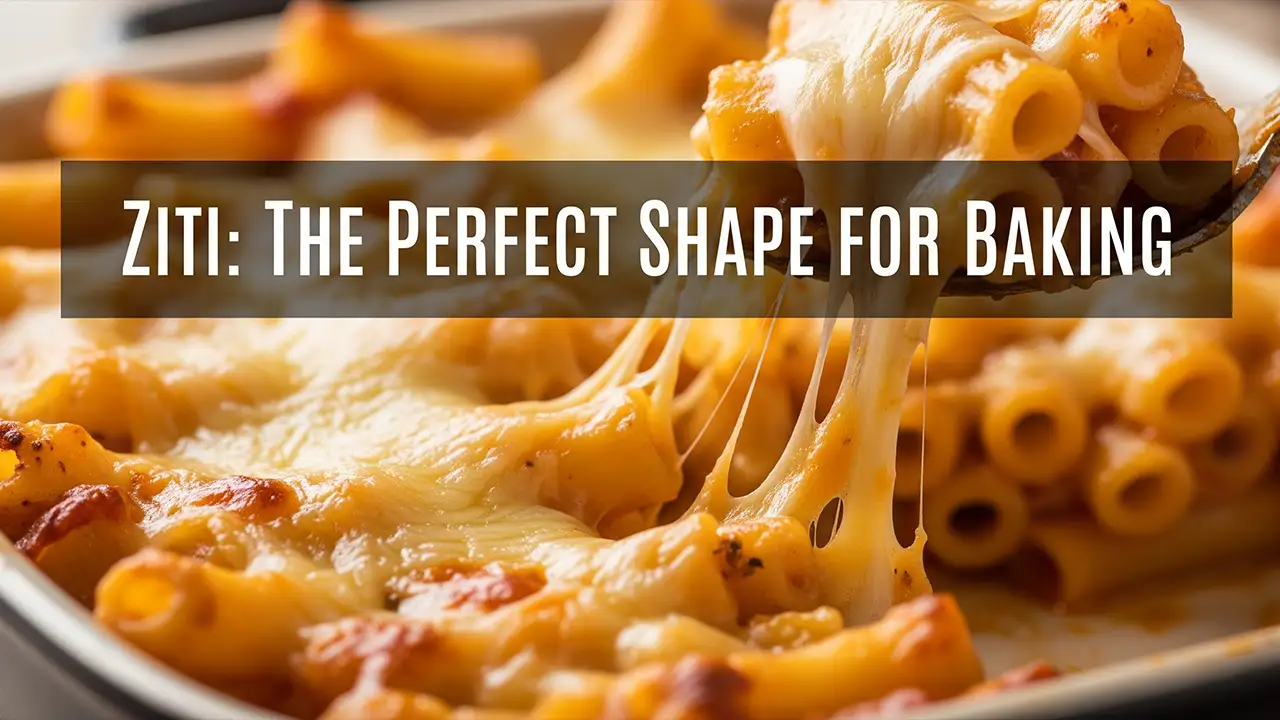
Have you ever wondered if the shape of your pasta really matters? For a simple weeknight meal, maybe not. But for a hearty oven-baked pasta dish, my friend, it is everything. It is the single most important decision you will make. We’ve all seen the evidence: the baked casserole where the sauce slides right off the noodles, or delicate shapes that collapse into a sad, mushy paste. The problem wasn’t your recipe; it was your architecture. This is my guide to the undisputed king of pasta construction, Ziti: The Perfect Shape for Baking.
Understanding why this humble tube is an engineering marvel is the key to unlocking spectacular results in all your baked pasta dishes, like a spectacular baked ziti. This guide will change the way you look at a box of pasta forever. This is the one insight you need.
So, let’s look past the sauce and the cheese for a moment. Let’s talk about the foundation. Let’s talk about the ziti pasta shape.
My Quest for Perfection: A Pasta Shape Love Story
For years, I treated all short, tubular pasta as interchangeable. Ziti, penne, rigatoni—I figured they were all just vessels for sauce. My pasta epiphany came when I was tasked with making two enormous pans of baked pasta for a family potluck. In a rush, I grabbed one box of ziti and one box of a different, smoother pasta shape. I made both dishes with the exact same sauce and cheese.
The difference was staggering. The other pasta dish was a mess. But the baked ziti? It was glorious. Each noodle held its shape and was full of sauce. The layers stood tall and proud.
That moment sent me on a deep dive into the history of ziti, a name derived from zita, the Italian word for bride, because it was traditionally served at wedding banquets in Southern Italy. It was designed to be substantial and to hold up to rich sauces and long cooking times. I realized my ancestors didn’t just choose this shape by accident. They chose it because it was structurally, scientifically, the perfect shape for the job. My quest became about understanding and sharing that structural genius and why ziti is the best pasta for baking.
The 7 Reasons Why the Ziti Pasta Shape is Perfect for Baking
The perfection of ziti for casseroles isn’t magic; it’s engineering. Its superiority is proven by understanding these seven essential characteristics.
Element 1: The Hollow Core – Ziti’s Secret for Sauce Adhesion
This is ziti’s greatest asset. Its hollow, tubular shape allows sauce to penetrate both inside and out. Unlike flat noodles, ziti doesn’t just get coated; it gets filled. Every piece becomes a self-contained vessel of flavor from a rich, slow-simmered sauce, ensuring no bite is ever dry.
Element 2: Moderate Diameter – For the Ideal Bite & Even Cooking
Ziti’s diameter is a masterstroke of design. It’s wide enough to allow sauce to enter, but not so wide that it feels clunky or falls apart. This moderate size provides a deeply satisfying bite and helps the pasta cook evenly.
Element 3: The Ridged Surface (Rigate) – For Maximum Sauce Cling
While smooth ziti exists, the ridged version, or ziti rigate, is the champion of baked dishes. Those fine grooves act like tiny trenches, grabbing onto sauce and melted cheese, ensuring perfect sauce adhesion.
Element 4: Sturdy Structure – The Key to Withstanding Baking
Ziti has thick, robust walls. This is crucial. Delicate pasta shapes can disintegrate under long bake times. The sturdy pasta structure of ziti, however, is built like a fortress, maintaining its perfect al dente bite.
Element 5: Architectural Integrity – Perfect for Layering
The straight, uniform tubes of ziti are like perfect little bricks. When layered, they interlock, creating a remarkably stable structure. This is why a well-made baked ziti can be cut into clean, proud squares that don’t collapse.
Element 6: Surprising Versatility – Perfect for Stuffing
While classic baked ziti doesn’t call for it, the shape’s potential is vast. The wide tubes are perfect for being individually stuffed with seasoned ricotta, showcasing its versatility as a perfect baking pasta.
Element 7: Uniformity – For Consistent Results Every Time
The consistent size and shape of each piece of ziti is your insurance policy for a predictable result. Every noodle cooks at the same rate, ensuring your oven-baked pasta is perfect from corner to corner.
How Should You Prep Ziti for the Best Baked Pasta Dishes?
Now that you understand why ziti is the perfect shape, let’s talk about how to prepare it to unlock its full potential.
- Salt the Water Generously: Bring a large pot of water to a rolling boil. You must salt it aggressively; the water should taste like a mild seawater. This is your only chance to season the pasta itself from the inside out.
- Cook to a Perfect Al Dente: This is non-negotiable. Cook the ziti for 2-3 minutes less than the package directs. It must be very firm. The pasta will absorb sauce and finish cooking in the oven, resulting in perfect al dente ziti.
- Drain, Don’t Rinse: Drain the cooked pasta immediately in a colander. Never rinse your pasta for a baked dish. Rinsing washes away the surface starches that help the sauce and cheese cling.
- Prevent Sticking Immediately: To prevent the draining ziti from sticking, immediately toss it with a cup or two of your sauce. This coats each piece, keeping them separate and giving them their first layer of flavor.
Your Baked Pasta Troubleshooting Guide: The Ziti Solution
This cheat sheet helps diagnose common baked pasta issues, framing them through the lens of ziti’s superior properties.
| The Problem | The Likely Cause(s) | The Ziti Solution |
| My baked pasta is dry. | The pasta shape couldn’t hold enough sauce. | Ziti’s hollow core (Element 1) is the solution. It acts as a reservoir, holding sauce inside each noodle to ensure a moist bake. |
| My pasta came out mushy. | A delicate pasta shape was used. | Ziti’s sturdy structure (Element 4) is built for baking. It maintains its integrity and al dente bite even after a long bake. |
| The sauce just slides off the noodles. | The pasta shape was too smooth. | Ziti Rigate’s ridged surface (Element 3) is designed for sauce adhesion. The ridges grab and hold onto sauce and cheese. |
| The dish collapses when I serve it. | The pasta shape was irregular, creating unstable layers. | Ziti’s uniform shape provides architectural integrity (Element 5). The tubes interlock to create stable layers that can be cut cleanly. |
| The cheese doesn’t melt evenly. | The pasta shape created an uneven surface. | Ziti’s uniform surface (Element 7) allows for an even distribution of sauce and cheese, ensuring a consistent, melted crust. |
Export to Sheets
Frequently Asked Questions About Ziti for Baking
- Is ziti better than penne for baked dishes? For classic layered casseroles, yes. Ziti’s straight-cut ends allow for more uniform stacking (Element 5). Penne’s angled ends can sometimes create a looser structure.
- Does ziti always need to be pre-cooked before baking? For my classic recipes, yes. Cooking it to al dente first is a critical step for achieving the perfect texture. No-boil versions require a different approach.
- Can I use other pasta shapes for baking? Of course, but choose wisely. Other sturdy shapes like rigatoni can work well. However, for a truly majestic layered dish like my Ultimate Ronzoni Lasagna, nothing beats a flat lasagna noodle.
- Can I substitute fresh ziti for dried? It’s not recommended for this type of baked dish. Fresh pasta is more delicate and will likely become too soft during the long baking time required for a casserole.
- How do I prevent ziti from sticking together after cooking? The secret is to immediately toss the drained pasta with a small amount of your sauce or a little olive oil.
Putting Ziti’s Perfection into Practice
Now that you understand why ziti is the undisputed king of baked pasta dishes, it’s time to see it in action. Its sturdy walls, hollow core, and perfect size make it the ideal foundation for holding rich ricotta, thick meat sauce, and glorious layers of melted cheese. It creates a final dish that is not just delicious, but structurally sound.
Ready to experience ziti’s baking perfection firsthand? Read my complete, step-by-step Ultimate Ronzoni Ziti Recipe.
